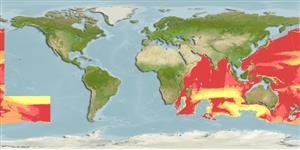Environment: milieu / climate zone / depth range / distribution range
Ekologi
laut batipelagis; kisaran kedalaman 892 - 1463 m (Ref. 26165). Subtropical
Western Pacific: Philippines and Indonesia to New Zealand, the Kermadecs and New Caledonia.
Size / Weight / umur
Maturity: Lm ? range ? - ? cm
Max length : 27.0 cm TL jantan/; (Ref. 26165)
A benthic species found on the continental slope (Ref. 75154).
Life cycle and mating behavior
Kematangan | Reproduksi, perkembang biakan | Pemijahan | telur-telur | Fecundity | Larva
Weitkamp, D.E. and R.D. Sullivan, 2003. Gas bubble disease in resident fish of the lower Clark Fork River. Trans. Am. Fish. Soc. 132(5):865-876. (Ref. 26165)
Status IUCN Red List (Ref. 130435: Version 2024-1)
ancaman kepada manusia
Harmless
penggunaan manusia
Alat, peralatan
laporan khas
muat turun XML
Sumber internet
Estimates based on models
Preferred temperature (Ref.
123201): 3 - 6, mean 4.5 °C (based on 378 cells).
Phylogenetic diversity index (Ref.
82804): PD
50 = 0.5001 [Uniqueness, from 0.5 = low to 2.0 = high].
Bayesian length-weight: a=0.01000 (0.00244 - 0.04107), b=3.04 (2.81 - 3.27), in cm total length, based on all LWR estimates for this body shape (Ref.
93245).
Trophic level (Ref.
69278): 3.2 ±0.3 se; based on size and trophs of closest relatives
Fishing Vulnerability (Ref.
59153): Low vulnerability (17 of 100).
